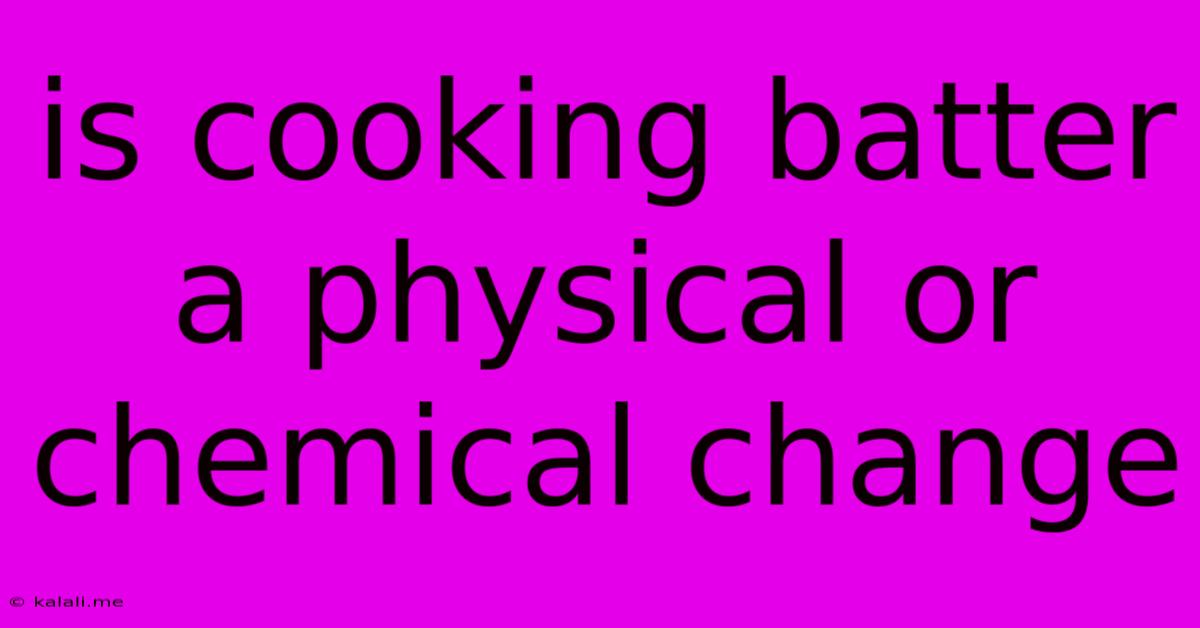Is Cooking Batter A Physical Or Chemical Change
Kalali
May 09, 2025 · 3 min read

Table of Contents
Is Cooking Batter a Physical or Chemical Change? A Deep Dive into Culinary Chemistry
Is making pancakes a simple kitchen chore, or a subtle science experiment? The answer lies in understanding whether cooking batter represents a physical or chemical change. This article will explore the fascinating intersection of cooking and chemistry, ultimately answering this question and uncovering the processes involved.
The seemingly simple act of cooking batter involves a complex interplay of ingredients undergoing both physical and chemical transformations. While some changes are easily reversible, others are permanent, indicating a definitive shift in the substance's composition. Let's delve into the details to determine the dominant change.
Understanding Physical and Chemical Changes
Before diving into the specifics of batter, let's establish a clear understanding of the two types of changes:
-
Physical Changes: These changes alter the form or appearance of a substance but do not change its chemical composition. Think about melting ice – it changes from solid to liquid, but it's still water (H₂O). Other examples include dissolving sugar in water, cutting an apple, or boiling water. These changes are often reversible.
-
Chemical Changes: These changes result in the formation of a new substance with different chemical properties. Burning wood is a chemical change, as the wood transforms into ash, smoke, and gases. The original wood is no longer present. Other examples include rusting iron, cooking an egg, or baking a cake. These changes are usually irreversible.
The Transformation of Batter: A Closer Look
When you mix batter ingredients – flour, eggs, milk, sugar, and leavening agents – you primarily initiate physical changes. The dry and wet ingredients are combined, creating a homogenous mixture. This is comparable to mixing sand and water; the components remain the same, just in closer proximity.
However, the real magic happens when you apply heat. This is where chemical changes become prominent. Here's a breakdown:
-
The Maillard Reaction: As the batter heats, the amino acids and reducing sugars interact, triggering the Maillard reaction. This complex chemical process produces hundreds of different flavour and aroma compounds, resulting in the characteristic brown colour and delicious scent of baked goods. This is an irreversible chemical change.
-
Protein Denaturation: The heat also denatures the proteins present in the eggs and flour. This means the proteins' structure unfolds and changes, resulting in a firmer, more solid texture. This alteration in the protein's structure is a chemical change.
-
Leavening Action: Baking powder or baking soda, if included, react with the heat and moisture to release carbon dioxide gas. This causes the batter to rise, creating the characteristic lightness and airy texture of baked goods. The gas production is a chemical change.
-
Starch Gelatinization: The starch granules in the flour absorb water and swell during heating, leading to a thickening of the batter. While the starch itself doesn't fundamentally change its chemical composition, the process of absorbing water and swelling is considered a physical change.
Conclusion: Predominantly Chemical
While the initial mixing of batter involves mostly physical changes, the act of cooking it is overwhelmingly dominated by chemical changes. The Maillard reaction, protein denaturation, leavening, and starch gelatinization are all irreversible chemical processes that fundamentally alter the batter's composition, creating a completely new substance – a cooked pancake, waffle, or other baked good. Therefore, cooking batter is primarily a chemical change. The subtle interplay between physical and chemical processes is what makes cooking such a fascinating and delicious science!
Latest Posts
Latest Posts
-
Standard Form Of A Polynomial Definition Math
May 09, 2025
-
How To Convert 6 11 To A Decimal
May 09, 2025
-
How Much Is 17 Oz In Cups
May 09, 2025
-
3 5 Grams Equals How Many Ounces
May 09, 2025
-
How Many Grams Are In 2 5 Kilograms
May 09, 2025
Related Post
Thank you for visiting our website which covers about Is Cooking Batter A Physical Or Chemical Change . We hope the information provided has been useful to you. Feel free to contact us if you have any questions or need further assistance. See you next time and don't miss to bookmark.